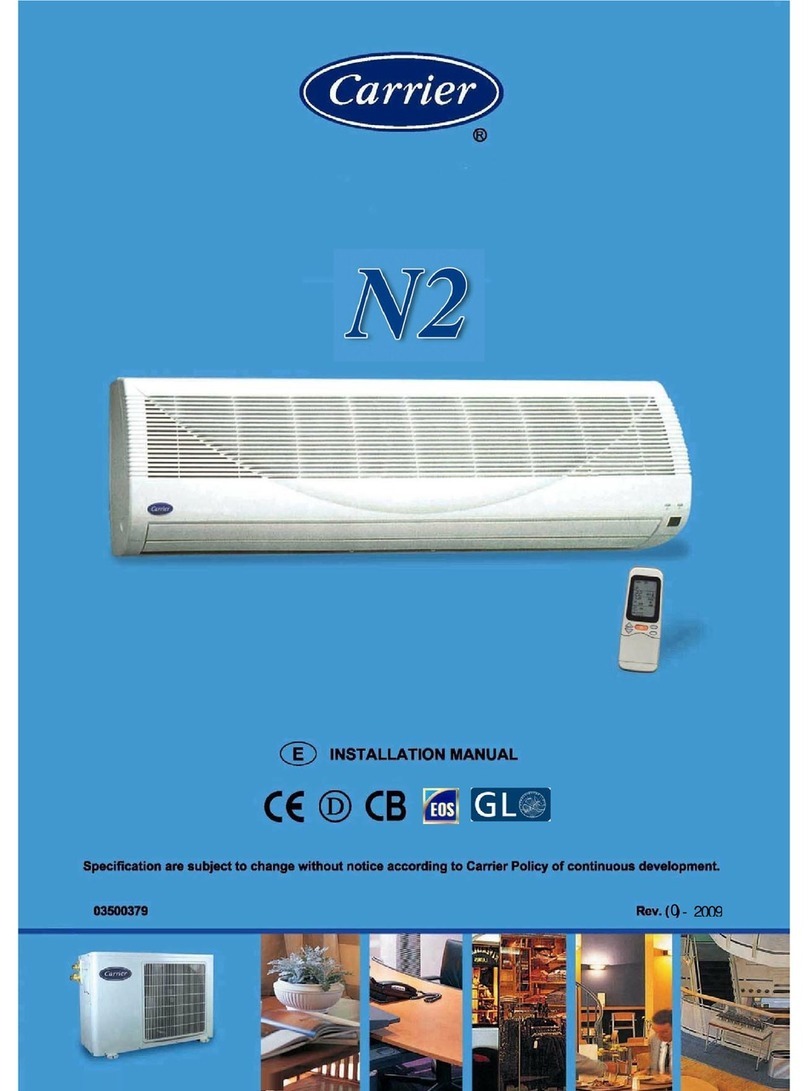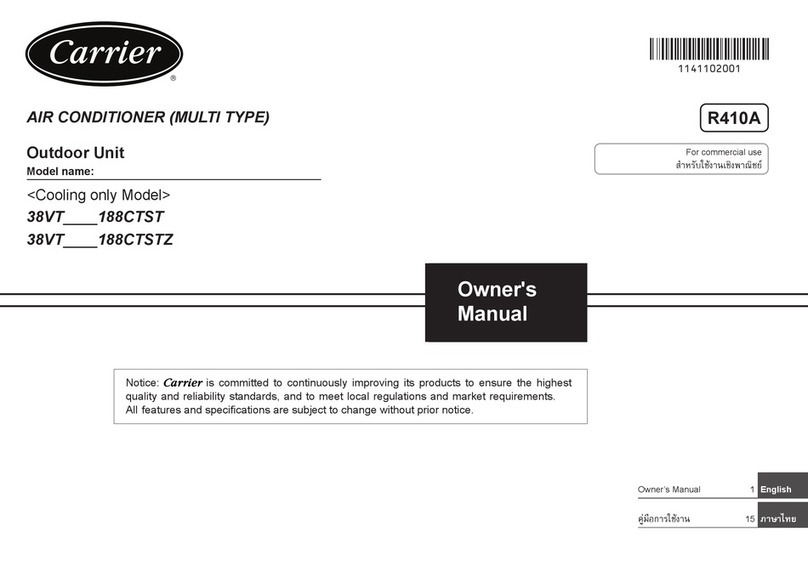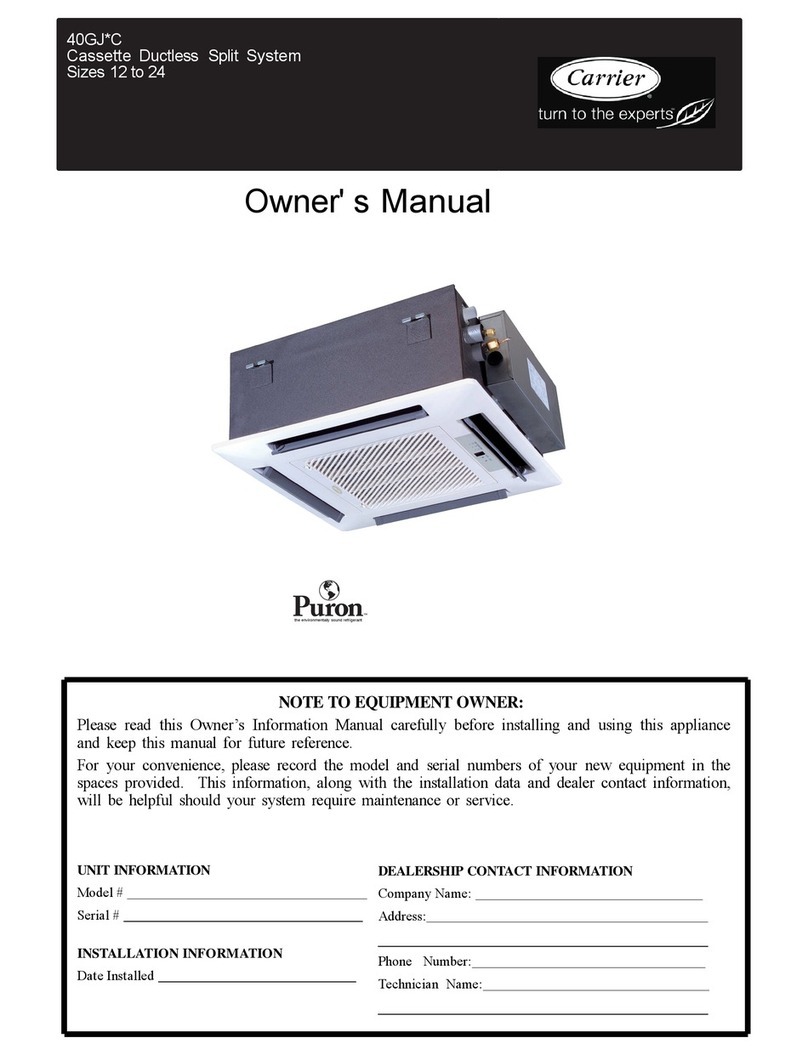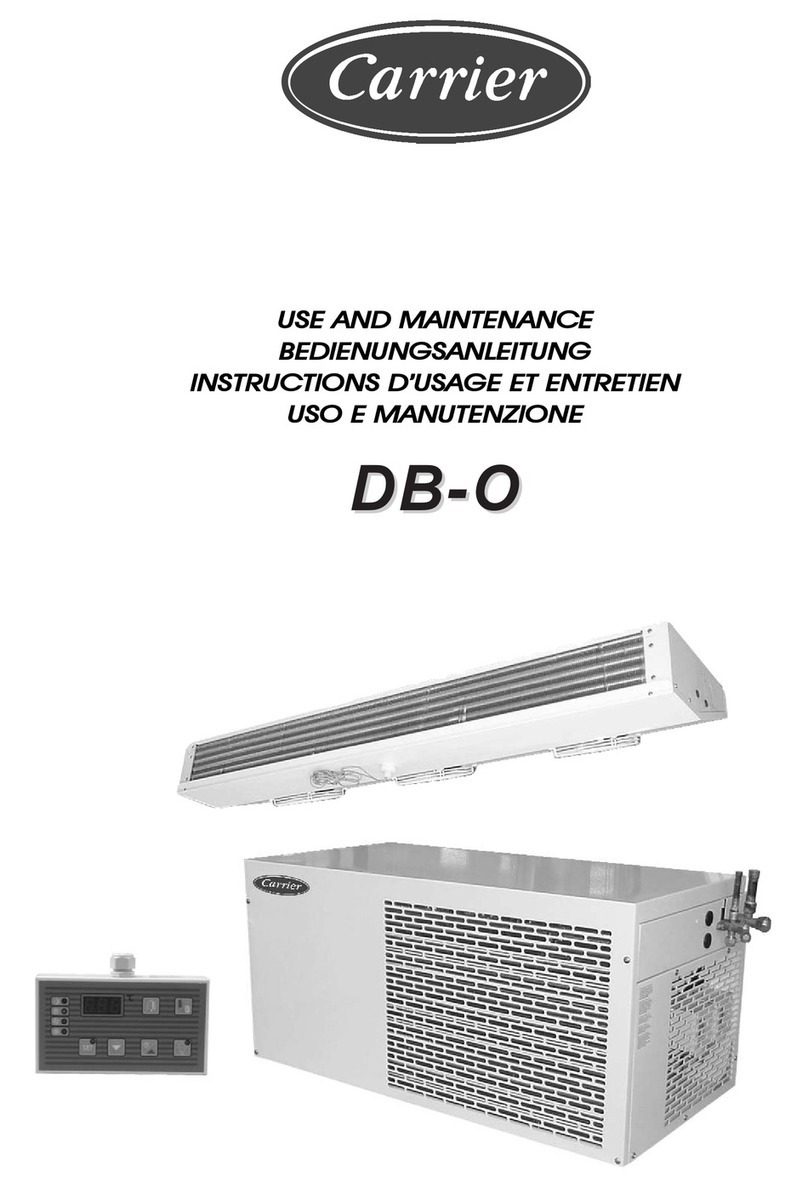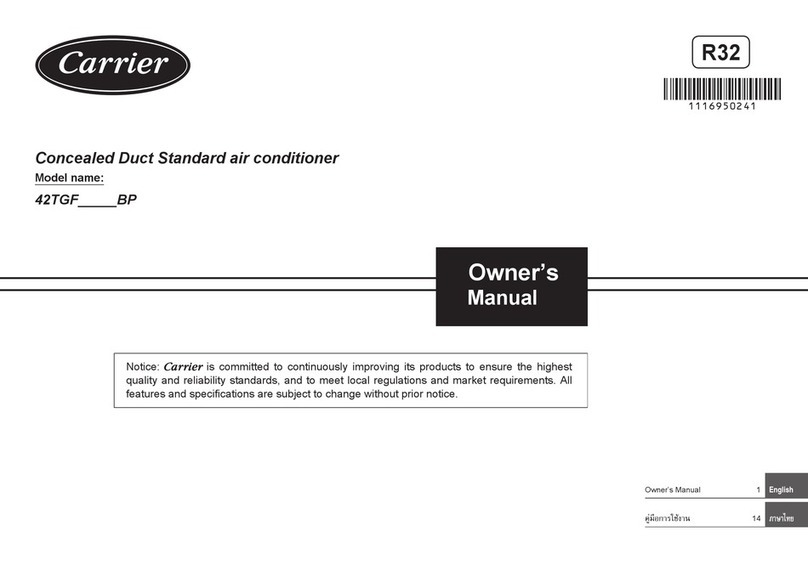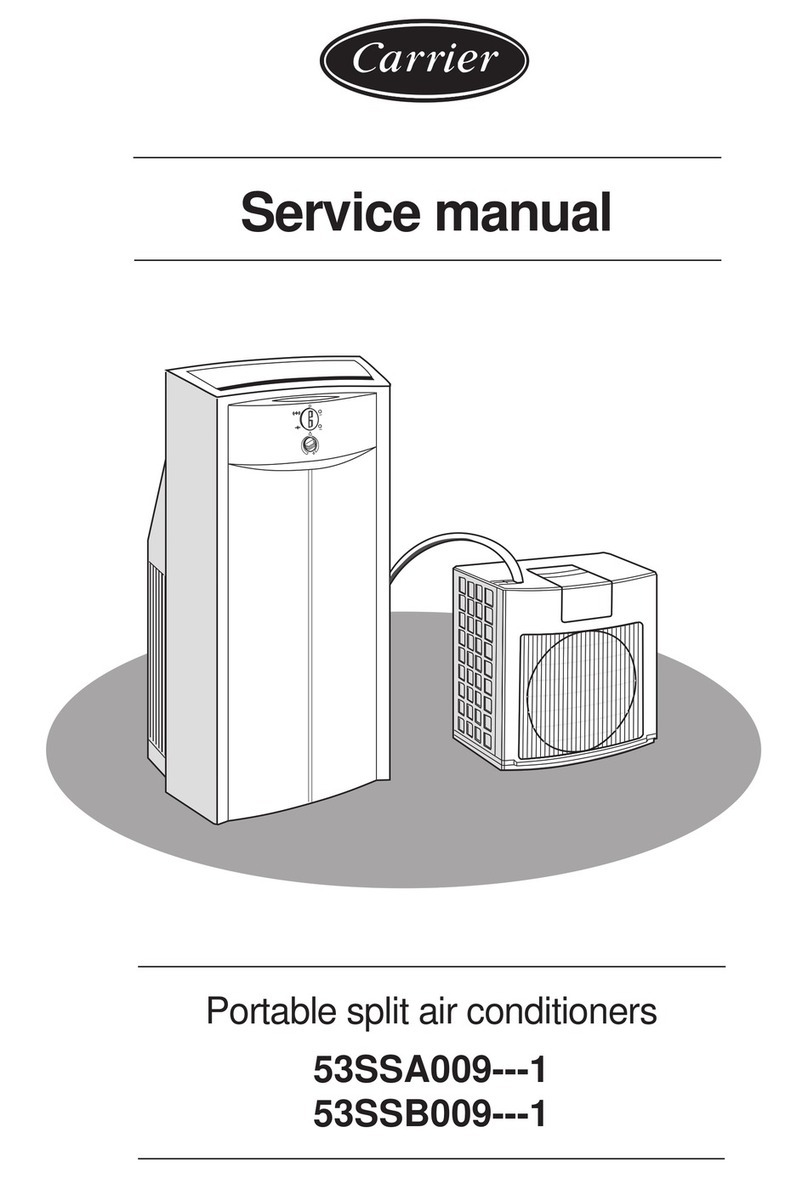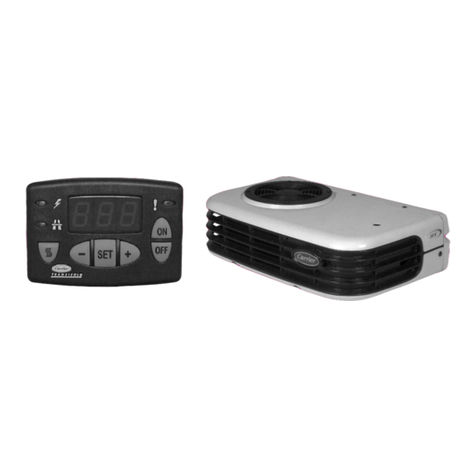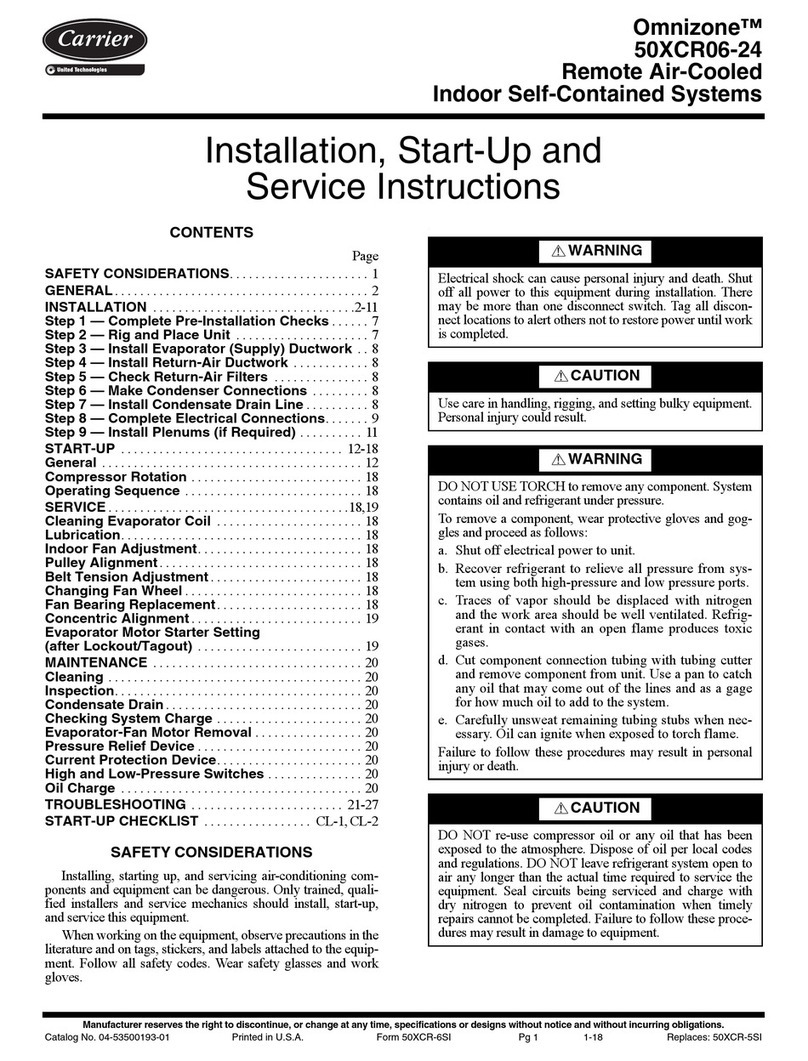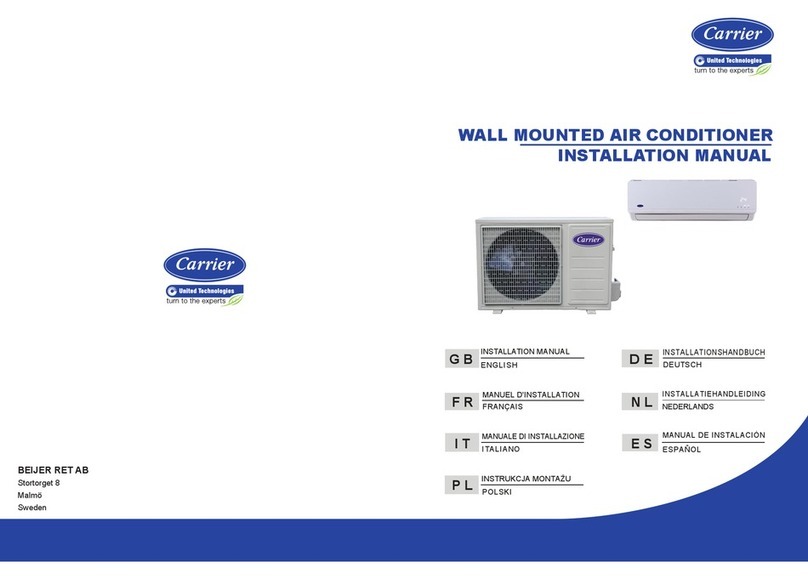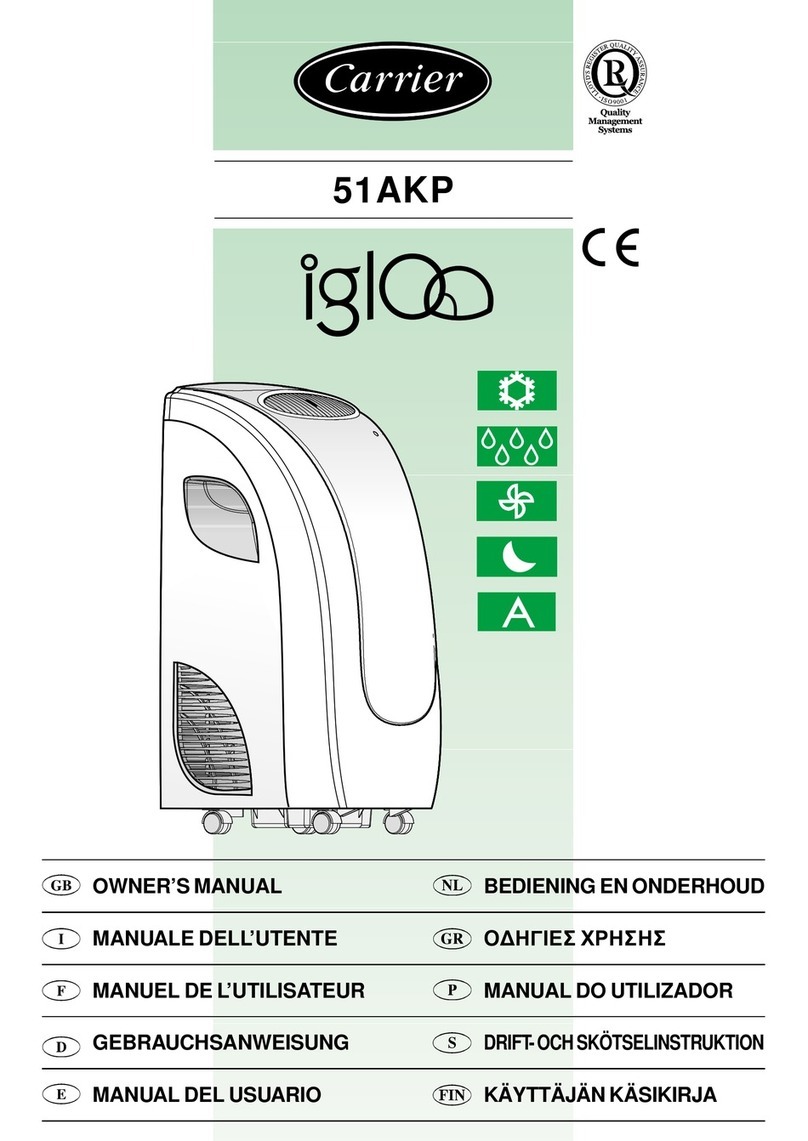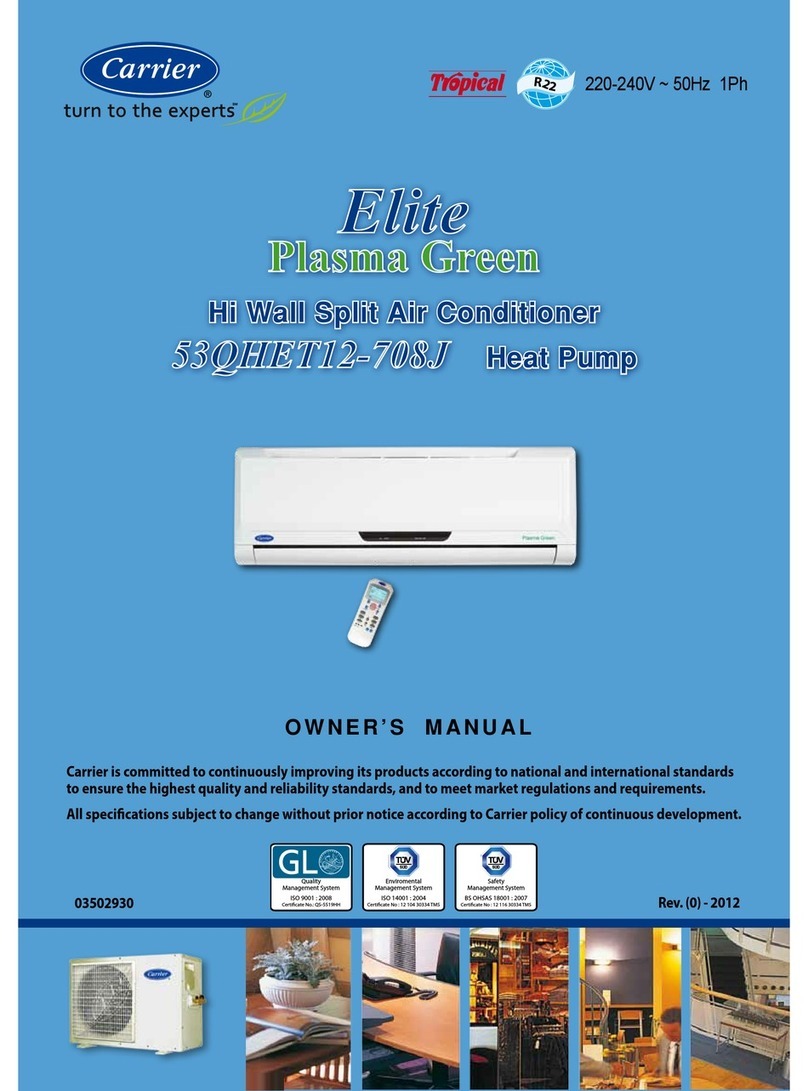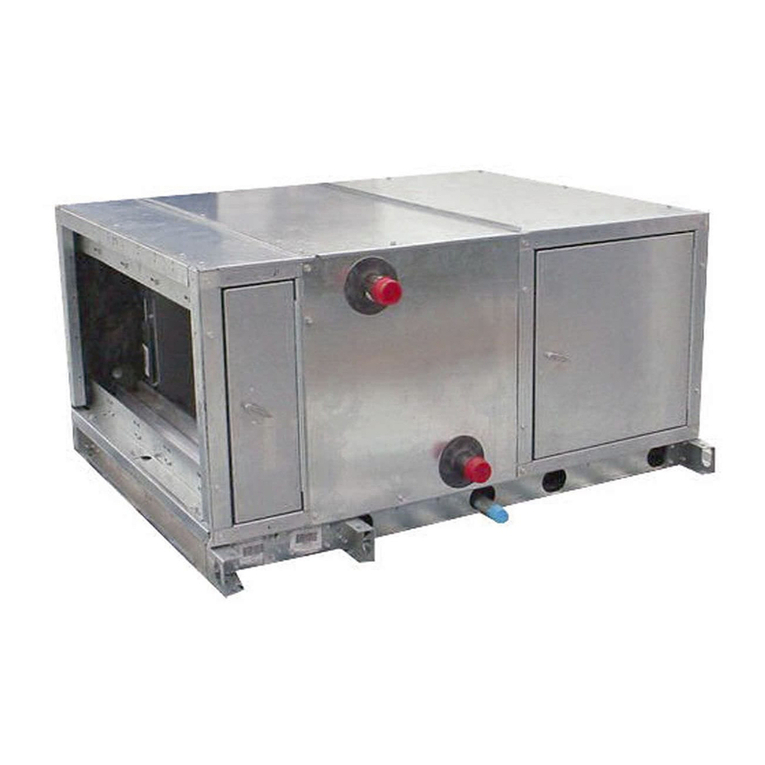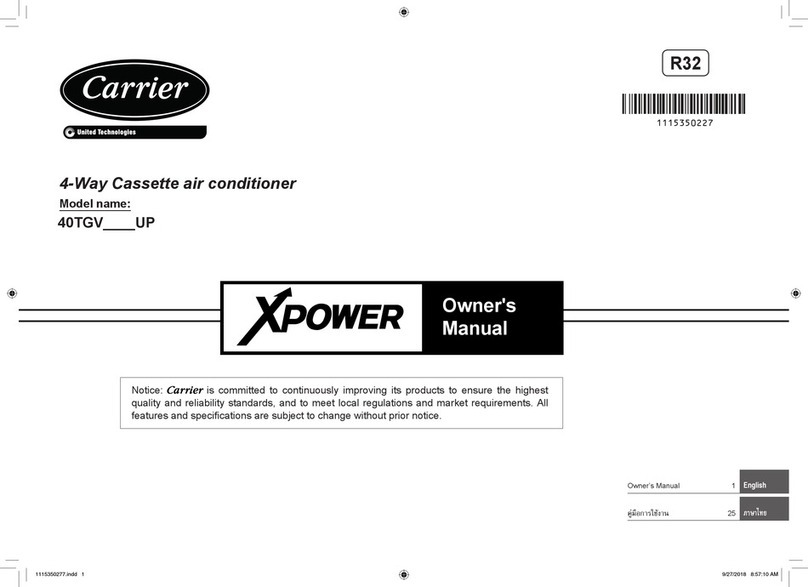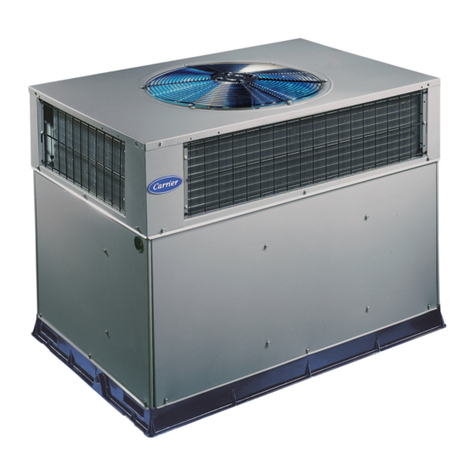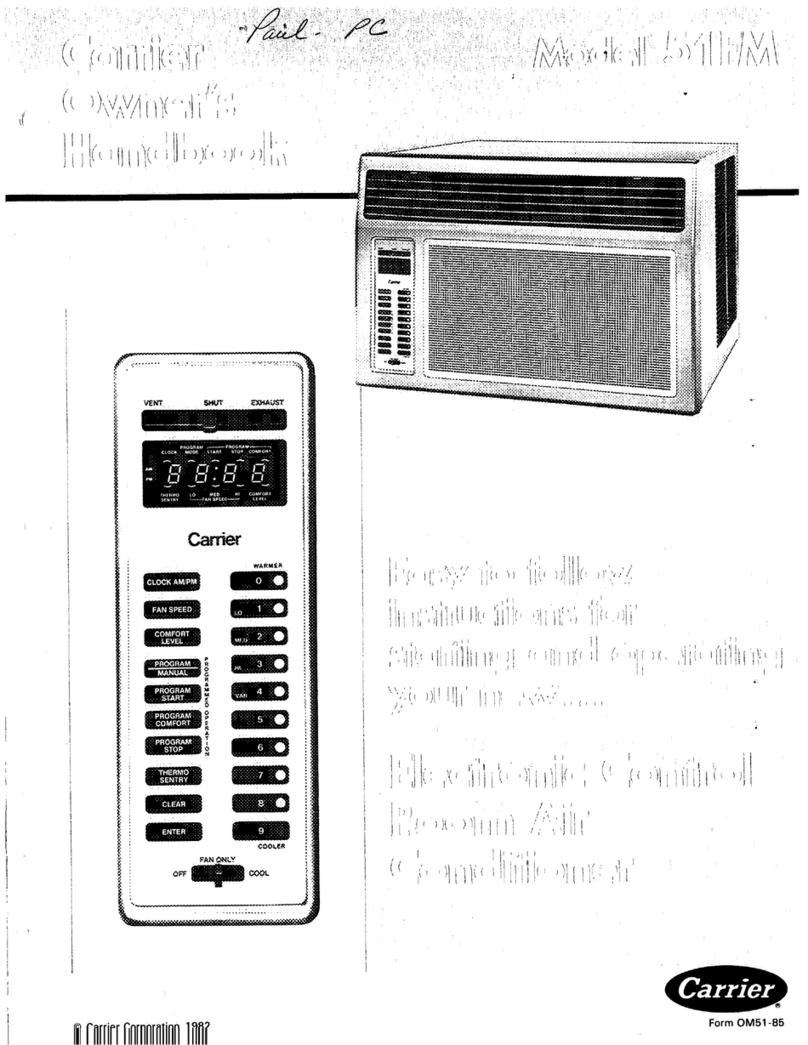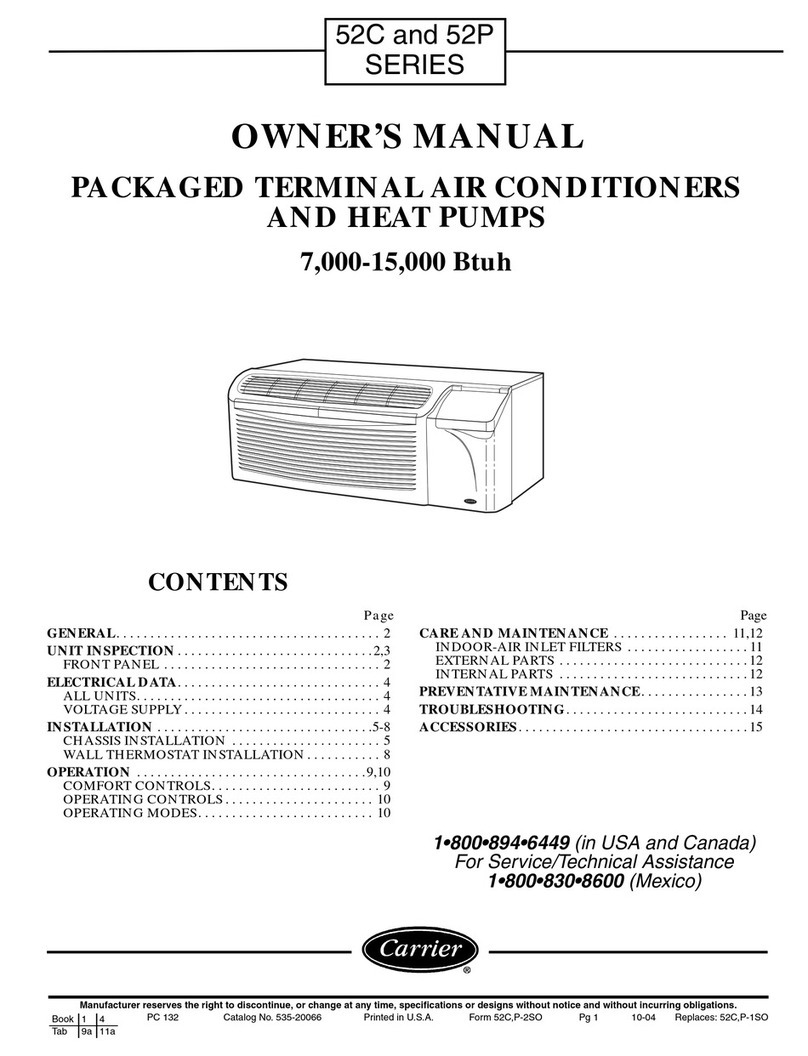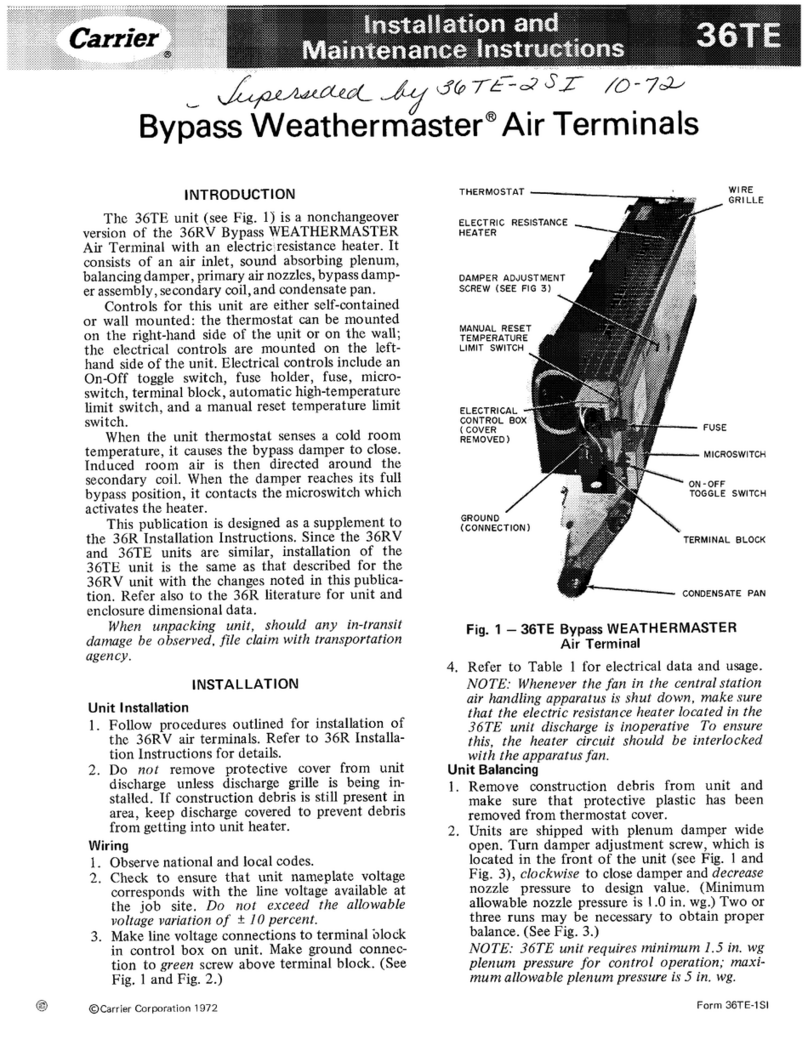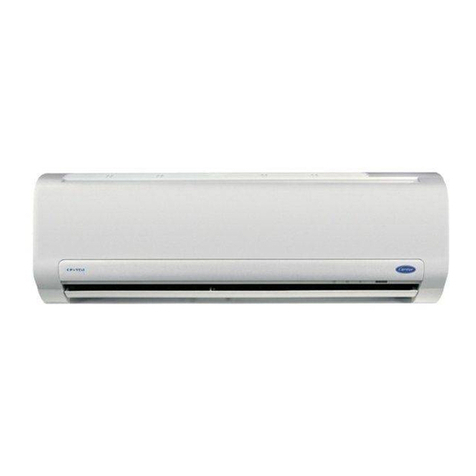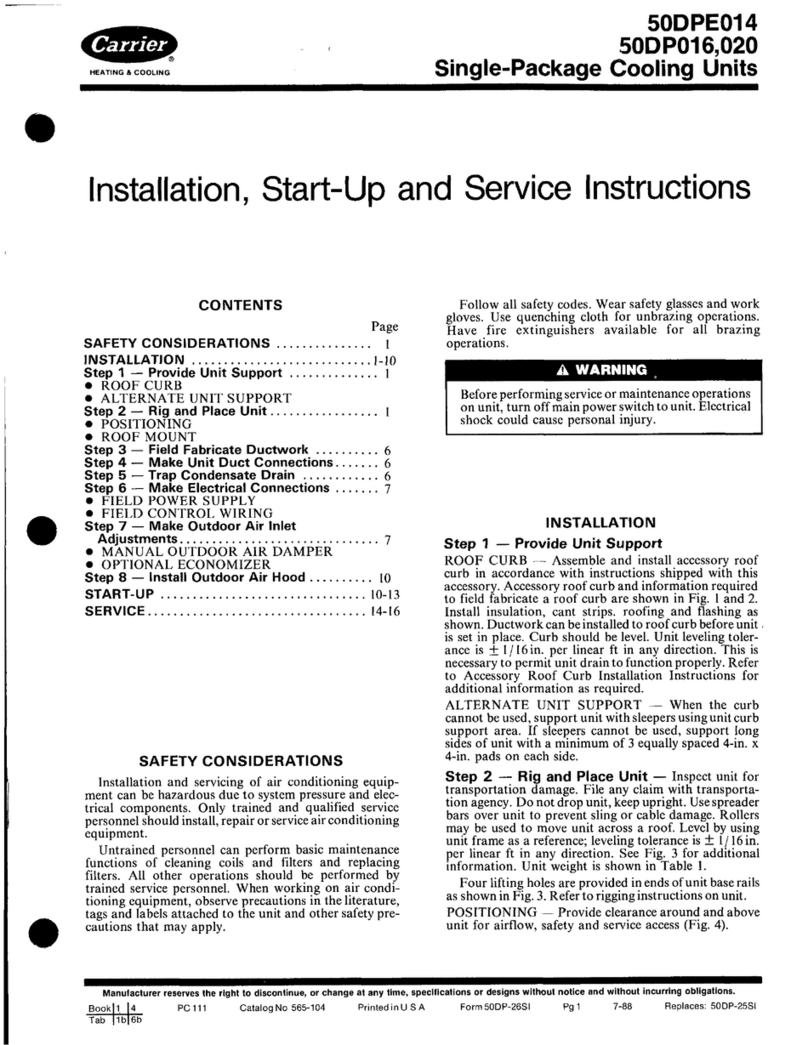
2
SEQUENCE OF OPERATION
Cooling, Units Without Economizer — When ther-
mostat calls for cooling, terminals G and Y1 are energized. The
indoor (evaporator) fan contactor (IFC) and compressor
contactor no. 1 (C1) are energized, and evaporator-fan motor
(IFM), compressor no. 1, and condenser fan(s) start. On
2-compressor units, outdoor-fan contactor (OFC) is energized
staring both outdoor fans. The fans continue to run until Y1 is
satisfied. The condenser-fan motor(s) runs continuously while
unit is cooling. For units with 2 stages of cooling, if the
thermostat calls for a second stage of cooling by energizing Y2,
compressor contactor no. 2 (C2) is energized and compressor
no. 2 starts.
Heating, Units Without Economizer — When the
thermostat calls for heating, terminal W1 is energized. In order
to prevent thermostat short-cycling, the unit is locked into the
Heating mode for at least 1 minute when W1 is energized. The
induced-draft motor (IDM) is then energized 20 seconds before
the burner ignition sequence begins. The indoor (evaporator)
fan motor (IFM) is energized 45 seconds after a flame is
proven. On units equipped for two stages of heat, when
additional heat is needed, W2 is energized and the high-fire
solenoid on the main gas valve (MGV) is energized. When the
thermostat is satisfied and W1 is deenergized, the IFM stops
after a 45-second time-off delay.
Cooling, Units With Durablade Economizer —
When the outdoor-air temperature is above the OAT (outdoor-
air thermostat) setting and the room thermostat calls for
cooling, compressor contactor no. 1 is energized to start
compressor no. 1 and the outdoor (condenser) fan motor
(OFM). The indoor (evaporator) fan motor (IFM) is energized
and the economizer damper moves to the minimum position.
Upon a further call for cooling, compressor contactor no. 2 will
be energized, starting compressor no. 2 (sizes 008-014 only).
On 2-compressor units, outdoor-fan contactor (OFC) is ener-
gized staring both outdoor fans. The fans continue to run until
Y1 is satisfied. After the thermostat is satisfied, the damper
moves to the fully closed position when using an auto fan or to
the minimum position when using a continuous fan.
When the outdoor-air temperature is below the OAT setting
and the thermostat calls for cooling, the economizer dampers
move to the minimum position. If the supply-air temperature is
above 57 F, the damper continues to open until it reaches the
fully open position or until the supply-air temperature drops
below 52 F.
When the supply-air temperature falls to between 57 F and
52 F, the damper will remain at an intermediate open position.
If the supply-air temperature falls below 52 F, the damper will
modulate closed until it reaches the minimum position or until
the supply-air temperature is above 52 F. When the thermostat
is satisfied and the indoor-fan motor is still in operation, the
damper will move to the minimum open setting. If the thermo-
stat is satisfied and the indoor-fan motor is deenergized, the
damper will move to the fully closed position.
If the outdoor air alone cannot satisfy the cooling require-
ments of the conditioned space, economizer cooling is integrated
with mechanical cooling, providing second-stage cooling.
Compressor no. 1 and the condenser fan will be energized and
the position of the economizer damper will be determined by the
supply-air temperature. Compressor no. 2 is locked out.
When the second stage of cooling is satisfied, the compres-
sor and OFM will be deenergized. The damper position will be
determined by the supply-air temperature.
After a 30-second delay, the IFM shuts off. If the thermostat
fan selector switch is in the ON position, the IFM will run
continuously.
Cooling, Units With EconoMi$er2 — When free
cooling is not available, the compressors will be controlled by
the zone thermostat. When free cooling is available, the
outdoor-air damper is positioned through the use of a
Proportional-Integral (PI) control process to provide a 55 F
supply-air temperature into the zone. If the mixed-air tempera-
ture is below the lower end of the set point of 50 F, then the
outside-air dampers will modulate to minimum position. If the
measured temperature is within the range of 50 to 56 F, then the
outside dampers will hold their current position. If the mixed
air temperature is above 56 F, then the outside-air dampers will
modulate open until the temperature is within range or they
modulate to the fully open position.
If outdoor air alone cannot satisfy the cooling requirements
of the conditioned space, and the OAT is above the outdoor air
mechanical lockout temperature set point (fixed; opens at 35 F,
closes at 50 F), the EconoMi$er2 integrates free cooling with
mechanical cooling as follows:
Y1 = 1st stage cooling using EconoMi$er2 damper for free
cooling
Y2 = 1st stage cooling using EconoMi$er2 damper for free
cooling plus compressor no. 1
NOTE: During EconoMi$er operation (damper above minimum
position) compressor no. 2 will not operate (sizes 008-014).
High ambient temperature (dry bulb) lockout (fixed): opens
at 76 F, closes at 52 F.
If the enthalpy of the outside air is too high, the outside-air
dampers will modulate to minimum position.
If mechanical cooling is utilized with free cooling, the
outdoor-air damper will be locked into its current position at
the time the compressor is started. If the increase in cooling
capacity causes the supply-air temperature to drop below 45 F,
then the outdoor-air damper position will be decreased to the
minimum position. If the supply temperature continues to fall,
the outdoor-air damper will close.
If optional power exhaust is installed, as the outdoor-air
damper opens and closes, the power exhaust fans will be
energized and deenergized.
If field-installed accessory CO2sensors are connected to the
EconoMi$er2 control, a PI-controlled demand ventilation
strategy will begin to operate. As the CO2level in the zone
increases above the CO2set point, the minimum position of the
damper will be increased proportionally. As the CO2level
decreases because of the increase in fresh air, the outdoor-air
damper will be proportionally closed.
Heating, Units With Economizer — When the ther-
mostat calls for heating, terminal W1 is energized. In order to
prevent thermostat short-cycling, the unit is locked into the
Heating mode for at least 1 minute when W1 is energized. The
induced-draft motor is then energized and the burner ignition
sequence begins. The indoor (evaporator) fan motor (IFM) is
energized 45 seconds after a flame is ignited and the damper
moves to the minimum position. On units equipped for two
stages of heat, when additional heat is needed, W2 is energized
and the high-fire solenoid on the main gas valve (MGV) is
energized. When the thermostat is satisfied and W1 is deener-
gized, the IFM stops after a 45-second time-off delay. The
economizer damper then moves to the fully closed position.
When using continuous fan, the damper will remain in the
minimum position.
